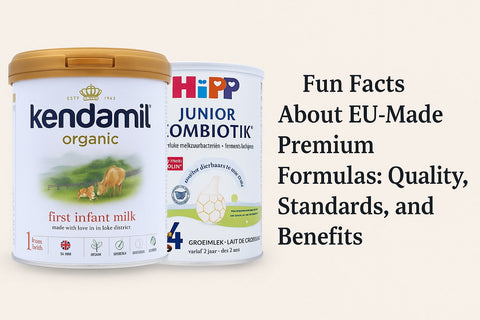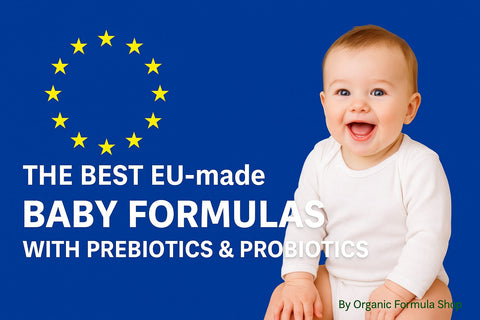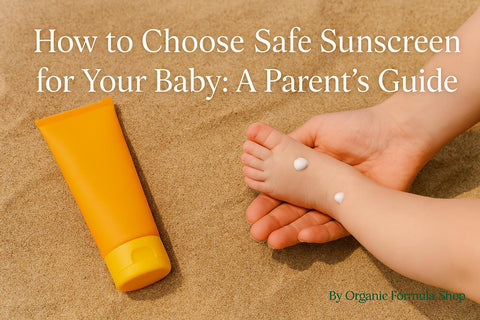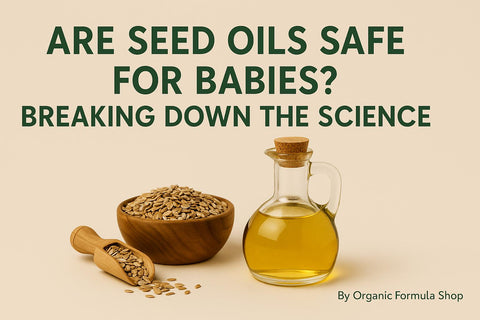HiPP Hydrolyzed Formulas vs. Similac Alimentum: A Guide for Parents
Selecting the right hypoallergenic formula for a baby with allergies or sensitivities is a critical decision for parents. Two leading options, HiPP Hydrolyzed Formulas (made for the European market) and Similac Alimentum (made in the US), are designed to support infants with cow’s milk protein allergies (CMPA) or digestive issues. For parents searching for HiPP HA Formulas in the USA, understanding how these specialized formulas compare is essential. This guide compares HiPP Hydrolyzed Formulas and Similac Alimentum, highlighting differences like stricter European Food Safety Authority (EFSA) regulations, ingredient profiles, and the impact of Operation Stork Speed. We’ll help you choose the best formula for your baby’s unique needs.
Things to Consider When Choosing Hypoallergenic Formulas
Before diving into the specifics of HiPP Hydrolyzed Formulas and Similac Alimentum, it’s important to understand key factors when selecting a hypoallergenic formula. First, consult a pediatrician to accurately diagnose whether your baby has a cow’s milk protein allergy (CMPA), lactose intolerance, or general digestive discomfort, as each condition requires a tailored approach. A pediatrician’s guidance ensures the formula matches your baby’s needs, avoiding unnecessary dietary restrictions. Second, consider your baby’s age, as roughly 50% of infants with CMPA outgrow it by 12 months. Monitoring changes in your baby’s health and nutritional needs is crucial, as they may transition to a standard formula later. Always discuss dietary shifts with a pediatrician to ensure safety. In my view, these considerations highlight the importance of personalized care in formula selection. Hypoallergenic formulas like HiPP and Similac Alimentum are specialized tools, but their effectiveness depends on precise diagnosis and age-appropriate use, empowering parents to make informed choices with professional support.
Lactose Intolerance vs. Cow’s Milk Protein Allergy

Understanding the difference between lactose intolerance and cow’s milk protein allergy (CMPA) is crucial when choosing a hypoallergenic formula, as these conditions affect infants differently and require distinct dietary solutions. Lactose intolerance, caused by a deficiency in the enzyme lactase, impairs the digestion of lactose (milk sugar), leading to symptoms like diarrhea, bloating, and gas. It’s rare in newborns. CMPA, affecting 5–7% of formula-fed infants, is an immune response to cow’s milk proteins, manifesting as IgE-mediated reactions (e.g., hives, wheezing, anaphylaxis) or non-IgE-mediated symptoms (e.g., vomiting, diarrhea, or blood in stool). Some babies experience both types, and a family history of allergies increases CMPA risk. This distinction underscores the need for accurate diagnosis, as lactose intolerance may require lactose-free formulas, while CMPA demands hydrolyzed or amino acid-based formulas like HiPP Hydrolyzed or Similac Alimentum. Misidentifying these conditions could lead to ineffective feeding choices, making pediatrician consultation essential for tailored care.
Why Compare HiPP Hydrolyzed Formulas and Similac Alimentum?
HiPP Hydrolyzed Formulas and Similac Alimentum are top choices for infants with allergies or sensitivities, making them worth comparing, especially for parents exploring HiPP Formula US.
HiPP Hydrolyzed Formulas

HiPP, a German family-run brand with over a century of expertise, is renowned for its organic and hypoallergenic formulas. Leveraging 25 years of immunology research, HiPP’s hydrolyzed formulas feature extensively hydrolyzed proteins to reduce allergenicity. These formulas adhere to strict EFSA standards and are ideal for babies with a family history of allergies, though they may not suit severe CMPA cases. The HiPP Hydrolyzed Formulas Organic Formula Shop carries are:
Similac Alimentum

Similac Alimentum, produced by Abbott Nutrition, is a US-based hypoallergenic formula designed for infants with CMPA, severe food allergies, or protein sensitivity-related colic. Using extensively hydrolyzed proteins and adhering to U.S. Food and Drug Administration (FDA) standards, Alimentum is available for parents to manage digestive discomfort with their little one.
While both formulas target sensitive tummies, HiPP’s EFSA-regulated, immune-supporting formulas contrast with Similac Alimentum’s FDA-compliant approach. Initiatives like Operation Stork Speed highlight gaps in US formula safety, making this comparison vital for parents seeking HiPP Formulas in the US.
Similarities Between HiPP Hydrolyzed Formulas and Similac Alimentum
HiPP Hydrolyzed Formulas and Similac Alimentum share several features that make them effective for infants with allergies:
-
- Extensively Hydrolyzed Proteins: Both use broken-down proteins to reduce allergenicity, easing digestion for babies with CMPA or sensitivities.
- DHA and ARA: Both include DHA and ARA for brain and eye development, sourced from organic oils (HiPP) or processed sources (Similac).
- Essential Vitamins and Minerals: Both are fortified with vital nutrients to support healthy growth.
- GMO-Free: Both are free from genetically modified organisms, ensuring cleaner ingredients.
- Eco-Friendly Packaging: Both use recyclable cans to maintain freshness and reduce waste.
Comparison Chart: Shared Features
|
Feature |
HiPP Hydrolyzed |
Similac Alimentum |
|---|---|---|
|
Extensively Hydrolyzed Proteins |
Yes |
Yes |
|
DHA & ARA |
Yes |
Yes |
|
Essential Vitamins & Minerals |
Yes |
Yes |
|
GMO-Free |
Yes |
Yes |
|
Eco-Friendly Packaging |
Yes |
Yes |
Key Differences Between HiPP Hydrolyzed Formulas and Similac Alimentum
While both formulas excel for sensitive infants, their differences stem from regulatory standards, ingredients, and formulation stages. Let’s explore these to help you choose between HiPP Formula US and Similac Alimentum.
1. Regulatory Standards: EFSA vs. FDA
- The primary difference lies in the regulatory frameworks:
- HiPP Hydrolyzed (EFSA Standards): Formulas like HiPP Hydrolyzed Dutch Formula - Stage 1 and HiPP Hydrolyzed Formula - Stage 2 follow EFSA and EU regulations, requiring:
- No synthetic pesticides, fertilizers, or GMOs.
- Strict limits on contaminants and additives.
- Comprehensive safety and nutritional testing.
- High animal welfare standards, including outdoor grazing.
- Similac Alimentum (FDA Standards): Adheres to FDA and USDA standards, which are less stringent. For example:
- FDA permits synthetic nutrients and additives banned in the EU.
- Testing is thorough but less extensive than EU protocols.
- Standards allow potential trace GMOs from manufacturing.
Key Takeaway: EFSA’s stricter standards ensure HiPP’s superior purity, making HiPP Formula USA a premium choice for hypoallergenic needs.
2. Organic Certification: European vs. American
The processes for achieving organic certification in Europe and the US differ significantly, impacting the production of hypoallergenic formulas:
-
HiPP Hydrolyzed (European Certification Process): In Europe, the EU Organic Certification process is highly rigorous, overseen by the EFSA. It involves strict controls on farming practices, banning synthetic pesticides, fertilizers, and GMOs, while mandating sustainable land management and high animal welfare standards, such as access to outdoor grazing. For hydrolyzed formulas the use of hydrolyzed proteins prevents organic certification under EU rules. However, HiPP maintains stringent quality controls, ensuring GMO-free ingredients and sustainable sourcing practices that align with its commitment to environmental stewardship and purity.
-
Similac Alimentum (American Certification Process): In the US, the USDA Organic Certification process is less stringent, allowing more flexibility in farming and manufacturing. It permits limited use of certain synthetic substances and does not require the same level of animal welfare or environmental sustainability as EU standards. Similac Alimentum does not pursue organic certification, and its production process allows for milk from cows free of artificial growth hormones but does not guarantee GMO-free status. The FDA’s oversight focuses more on safety and nutritional adequacy than on ecological or purity standards, resulting in a broader, less restrictive manufacturing approach.
3. Operation Stork Speed: Addressing US Formula Safety
Launched on March 18, 2025, by Health and Human Services Secretary Robert F. Kennedy Jr., Operation Stork Speed aims to enhance US infant formula safety, prompted by the 2022 formula shortage and concerns about contaminants like arsenic and lead. It includes a nutrient review (first since 1998), increased heavy metal testing, and clearer labeling. This highlights gaps in FDA oversight compared to EFSA’s protocols, giving HiPP an edge in safety.
4. Ingredients: Probiotics, Carbohydrates, and Oils
HiPP Hydrolyzed and Similac Alimentum differ in their ingredient profiles:
-
Probiotics and Prebiotics:
- HiPP Hydrolyzed: Includes prebiotics (GOS) and probiotics (Lactobacillus fermentum) in formulas like HiPP Hydrolyzed Dutch Formula - Stage 1, supporting gut health and immunity.
- Similac Alimentum: Lacks probiotics and prebiotics, offering less digestive and immune support.
-
Carbohydrates:
- HiPP Hydrolyzed: Uses lactose as the primary carbohydrate, mimicking breast milk for gentle digestion, with no added sugars or artificial sweeteners.
- Similac Alimentum: Uses corn maltodextrin and sucrose (table sugar) as carbohydrate sources, which may improve taste but are less ideal per American Academy of Pediatrics (AAP) guidelines avoiding added sugars for infants under 2.
-
Vegetable Oils:
- HiPP Hydrolyzed: Uses sustainably sourced organic palm, sunflower, and rapeseed oils.
- Similac Alimentum: Includes palm olein, soy, and safflower oils, with non-sustainable palm oil potentially linked to digestive issues.
5. Iron Levels: A Critical Consideration for Newborns
Newborns have iron reserves for the first 4-6 months, making excessive iron potentially harmful, causing digestive issues or microbiome imbalances. EFSA-regulated HiPP Hydrolyzed formulas, like HiPP Hypoallergenic Formula - Stage Pre, have low iron (0.5-0.7 mg/100ml) for newborns. FDA-regulated Similac Alimentum has higher iron levels (1.8 mg/100ml), which may be excessive for younger infants, potentially causing discomfort. EFSA’s precision gives HiPP Formula US an advantage.
6. Formulation Stages: Tailored Nutrition
HiPP Hydrolyzed and Similac Alimentum approach developmental stages differently:
-
HiPP Hydrolyzed Stages (up to 3 Stages):
- Stage Pre (0-6 months): Low iron (0.5-0.7 mg/100ml), no starch, for newborns with allergies (HiPP Hypoallergenic Formula - Stage Pre).
- Stage 1 (0-6 months): Low iron (0.5-0.7 mg/100ml), for term newborns (HiPP Hydrolyzed Dutch Formula - Stage 1, HiPP Hydrolyzed Formula - Stage 1).
- Stage 2 (6-12 months): Higher iron (1.0-1.2 mg/100ml) for older infants (HiPP Hydrolyzed Formula - Stage 2, HiPP Hydrolyzed Dutch Formula - Stage 2).
-
Similac Alimentum Stages (Single Stage):
- Infant Formula (0-12 months): Consistent iron (1.8 mg/100ml), potentially high for newborns, designed for CMPA and severe allergies.
Environmental and Sustainability Practices

HiPP leads in sustainability, sourcing milk from farms prioritizing animal welfare and using sustainably sourced palm oil in formulas like HiPP Hydrolyzed Dutch Formula - Stage 1. It employs recyclable packaging and follows EFSA’s eco-conscious standards. Similac Alimentum uses recyclable cans but relies on non-sustainable palm oil and broader manufacturing, limiting its environmental scope.
Why It Matters: HiPP’s sustainability appeals to eco-conscious parents seeking HiPP Formula US, while Similac Alimentum suits those prioritizing affordability.
Conclusion: Why HiPP Hydrolyzed Formulas Stand Out
Both HiPP Hydrolyzed Formulas and Similac Alimentum are excellent for infants with allergies, but HiPP’s immune-supporting composition, EFSA compliance, and stage-specific formulations make it a premium choice for parents exploring HiPP Formula USA.
benefit from stricter EU regulations, ensuring high purity and digestive support, as highlighted by Operation Stork Speed’s critique of US standards. Similac Alimentum’s affordability and suitability for severe CMPA are strong, but its use of corn maltodextrin, sucrose, and less rigorous FDA oversight place it behind HiPP.
For parents seeking gentle, immune-supporting nutrition, HiPP’s hydrolyzed formulas with probiotics and prebiotics are top-tier. Similac Alimentum is ideal for budget-conscious families with CMPA needs, but HiPP leads in quality.
Order your HiPP HA Formulas Here. ***We ship every order (for free!) in just 2 to 4 business days, faster than anyone else, anywhere in the US! ***
Contact
Contact our dedicated customer support team for expert advice and guidance tailored to your baby's needs. They have earned hundreds of 5-star reviews from our customers, helping you to provide the best nutrition for your little one. Contact us here or shoot us an email at support@organicformulashop.com. We're here to help!
Disclaimer: The information provided in this blog reflects the current product details from HiPP and Similac as of the publication date. While we strive to provide accurate and up-to-date information based on official brand sources, we have not independently verified all specifics. Product formulations, ingredients, packaging, and other details may change without prior notice. We recommend checking the latest information and consulting healthcare professionals or pediatricians before deciding on infant formula feeding.




